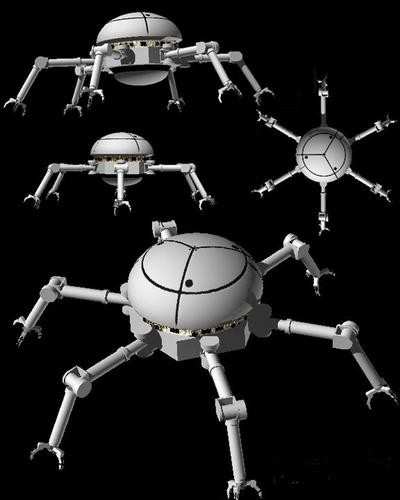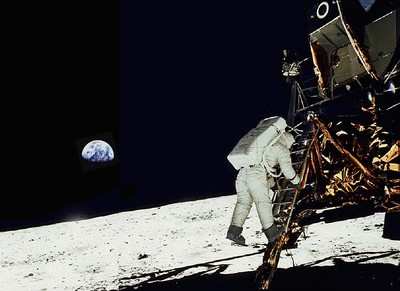Tue, Dec 21, 2004
Company Offers New Ideas for Human and Robotic Space
Exploration
NASA has selected six Northrop Grumman Corporation proposals
valued at approximately $137 million over four years to develop
human and robotic technologies that would have pivotal roles in its
Vision for Space Exploration.

The awards cover a variety of company-proposed concepts to help
NASA conduct sustainable and affordable exploration missions beyond
low-Earth orbit. NASA's Office of Exploration Systems Research and
Technology (ESR&T) is funding the proposals. Work is expected
to begin in early 2005.
Examples of technologies the company will develop for the
initiative include:
- An insect-like robot to autonomously inspect and maintain
exteriors of spacecraft, such as the Space Shuttle, International
Space Station or the proposed Crew Exploration Vehicle. The
six-legged robot would improve astronaut safety by reducing
extravehicular activities.
- A restowable, heat-resistant "skirt" that deploys around a
spacecraft just before reentry. By slowing the spacecraft
significantly, the skirt reduces heat damage to the spacecraft,
giving NASA a cost-effective option to re-use major elements of the
spacecraft for future exploration missions.
- An engine for a "space ferry" that would carry people and cargo
between the Lunar surface and Lunar orbit as needed. The engine
would be re-fueled from materials mined on the moon, improving
affordability by greatly decreasing the use of one-time, expendable
equipment.
"The selection of these proposals recognize that Northrop
Grumman's fresh ideas and creative uses of existing technologies
are part of the 'new thinking' that will be needed to meet the
renewed challenge of space exploration," said Sonya Sepahban,
Northrop Grumman Space Technology vice president and corporate lead
executive for exploration systems research and technology. "We have
a heritage of innovation that has delivered assured capabilities to
many space programs, from the Pioneer spacecraft to the Chandra
X-ray Observatory. We'll apply the same imaginative approaches
that'll help open new frontiers and make new discoveries as NASA
charts a new course through the cosmos," she added.

In addition to the three previously described, other company
proposals the company will pursue under the NASA awards
include:
- Small, easily producible phased-array antennas for satellites
using a low-cost electrically scanned array. This could reduce
these antennas by 10 times in cost and size while providing
extremely fast communications for space, ground and exploration
vehicles.
- An "open systems," health-management architecture that will
demonstrate new ways to monitor and manage, on an integrated basis,
the health, status and resource availability of the major
subsystems required to operate and maintain a space exploration
system.
- A family of lightweight, self-cleaning, anti-contamination
coatings to address dust mitigation requirements for future moon
and Mars missions.

"The maturation of these key technologies will help NASA
reach its goal of implementing an integrated space exploration
architecture that's technically achievable, logistically
supportable and economically sustainable well into the future,"
said Doug Young, Northrop Grumman Integrated Systems' director of
space systems and corporate lead executive for Project
Constellation. "We will continue to identify additional critical
technologies that will be needed as NASA extends its space
exploration initiative to Mars and beyond."
More News
He Attempted To Restart The Engine Three Times. On The Third Restart Attempt, He Noticed That Flames Were Coming Out From The Right Wing Near The Fuel Cap Analysis: The pilot repor>[...]
Make Sure You NEVER Miss A New Story From Aero-News Network Do you ever feel like you never see posts from a certain person or page on Facebook or Instagram? Here’s how you c>[...]
From 2009 (YouTube Edition): Leading Air Show Performers Give Their Best Advice for Newcomers On December 6th through December 9th, the Paris Las Vegas Hotel hosted over 1,500 air >[...]
Aero Linx: NASA ASRS ASRS captures confidential reports, analyzes the resulting aviation safety data, and disseminates vital information to the aviation community. The ASRS is an i>[...]
“For our inaugural Pylon Racing Seminar in Roswell, we were thrilled to certify 60 pilots across our six closed-course pylon race classes. Not only did this year’s PRS >[...]
 NTSB Final Report: Rutan Long-EZ
NTSB Final Report: Rutan Long-EZ ANN FAQ: Turn On Post Notifications
ANN FAQ: Turn On Post Notifications Classic Aero-TV: ICAS Perspectives - Advice for New Air Show Performers
Classic Aero-TV: ICAS Perspectives - Advice for New Air Show Performers ANN's Daily Aero-Linx (06.28.25)
ANN's Daily Aero-Linx (06.28.25) Aero-News: Quote of the Day (06.28.25)
Aero-News: Quote of the Day (06.28.25)




